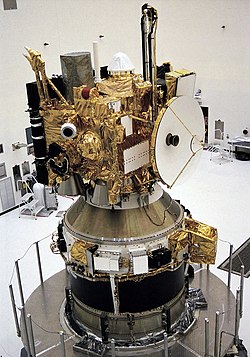| Mars Observer Camera (MOC) |

- see diagram | | Objectives [7] |
|---|
- Obtain global synoptic views of the Martian atmosphere and surface to study meteorological, climatological, and related surface changes.
- Monitor surface and atmosphere features at moderate resolution for changes on time scales of hours, days, weeks, months and years.
- Systematically examine local areas at extremely high spatial resolution in order to quantify surface/atmosphere interactions and geological processes.
|
Consists of narrow-angle and wide-angle telescopic cameras to study the meteorology/climatology and geoscience of Mars. [13] |
|
|
| Mars Observer Laser Altimeter (MOLA) |

- see diagram | | Objectives [7] |
|---|
- Provide topographic height measurements with a vertical resolution better than 0.5% of the elevation change within the footprint.
- Provide RMS slope information over the footprint.
- Provide surface brightness temperatures at 13.6 GHz with a precision of better than 2.5K.
- Provide well sampled radar return wave forms for precise range corrections and the characterization of surface properties.
|
A laser altimeter used to define the topography of Mars. [14] - Principal investigator: David Smith / NASA Goddard Space Flight Center
- reincorporated on Mars Global Surveyor
|
|
|
| Thermal Emission Spectrometer (TES) |

- see diagram | | Objectives [7] |
|---|
- Determine and map the composition of surface minerals, rocks and ice.
- Study the composition, particle size, and spatial and tempora distribution of atmospheric dust.
- Locate water-ice and carbon dioxide condensate clouds and determine their temperature, height and condensate abundance.
- Study the growth, retreat and total energy balance of the polar cap deposits.
- Measure the thermophysical properties of the Martian surface (thermal inertia, albedo) used to derive surface particle size and rock abundance.
- Determine atmospheric temperature, pressure, water vapor, and ozone profiles, and seasonal pressure variations.
|
Uses three sensors (Michelson interferometer, solar reflectance sensor, broadband radiance sensor) to measure thermal infrared emissions to map the mineral content of surface rocks, frosts and the composition of clouds. [15] - Principal investigator: Philip Christensen / Arizona State University
- reincorporated on Mars Global Surveyor
|
|
|
| Pressure Modulator Infrared Radiometer (PMIRR) |
 | | Objectives [7] |
|---|
- Map the three-dimensional and time-varying thermal structure of the atmosphere from the surface to 80 km altitude.
- Map the atmospheric dust loading and its global, vertical and temporal variation.
- Map the seasonal and spatial variation of the vertical distribution of atmospheric water vapor to an altitude of at least 35 km.
- Distinguish between atmospheric condensates and map their spatial and temporal variation.
- Map the seasonal and spatial variability of atmospheric pressure.
- Monitor the polar radiation balance.
|
Uses narrow-band radiometric channels and two pressure modulation cells to measure atmospheric and surface emissions in the thermal infrared and a visible channel to measure dust particles and condensates in the atmosphere and on the surface at varying longitudes and seasons. [16] |
|
|
| Gamma Ray Spectrometer (GRS) |

- see diagram | | Objectives [7] |
|---|
- Determine the elemental composition of the surface of Mars with a spatial resolution of a few hundred kilometers through measurements of incident gamma-rays and albedo neutrons (H, 0, Mg, Al, Si, S, Cl, K, Fe, Th, U).
- Determine hydrogen depth dependence in the top tens of centimeters.
- Determine the atmospheric column density.
- Determine the arrival time and spectra of gamma-ray bursts.
|
Records the spectrum of gamma rays and neutrons emitted by the radioactive decay of elements contained in the Martian surface. [17] |
|
|
| Magnetometer and Electron Reflectometer (MAG/ER) |
 | | Objectives [7] |
|---|
- Establish the nature of the magnetic field of Mars.
- Develop models for its representation, which take into account the internal sources of magnetism and the effects of the interaction with the solar wind.
- Map the Martian crustal remanlint field using the fluxgate sensors and extend these in-situ measurements with the remote capability of the electron-reflectometer sensor.
- Characterize the solar wind/Mars plasma interaction.
- Remotely sense the Martian ionosphere.
|
Uses the components of the on-board telecommunications system and the stations of the Deep Space Network to collect data on the nature of the magnetic field and interactions the field may have with solar wind. [18] - Principal investigator: Mario Acuna / NASA Goddard Space Flight Center
- reincorporated on Mars Global Surveyor
|
|
|
| Radio Science experiment (RS) |
 | | Objectives [7] |
|---|
Atmosphere- Determine profiles of refractive index, number density, temperature, and pressure at the natural experimental resolution (approx. 200 m) for the lowest few scale heights at high latitudes in both hemispheres on a daily basis.
- Monitor both short term and seasonal variation in atmospheric stratification.
- Characterize the thermal response of the atmosphere to dust loading.
- Explore the thermal structure of the boundary layer at high vertical resolution (approx. 10 m).
- Determine the height and peak plasma density of the daytime ionosphere.
- Characterize the small scale structure of the atmosphere and ionosphere.
| Gravity- Develop a global, high-resolution model for the gravitational field.
- Determine both local and broad scale density structure and stress state of the Martian crust and upper mantle.
- Detect and measure temporal changes in low degree harmonics of the gravitational field.
|
Collects data on the gravity field and the Martian atmospheric structure with a special emphasis on temporal changes near the polar regions. [19] |
|
|
| Mars Balloon Relay (MBR) |
| Planned as augmentation to return data from the penetrators and surface stations of the Russian Mars '94 mission and from penetrators, surface stations, a rover, and a balloon from the Mars '96 mission. [20] - Principal investigator: Jacques Blamont / Centre National de la Recherche Scientifique
- reincorporated on Mars Global Surveyor
|
|
|
|



























